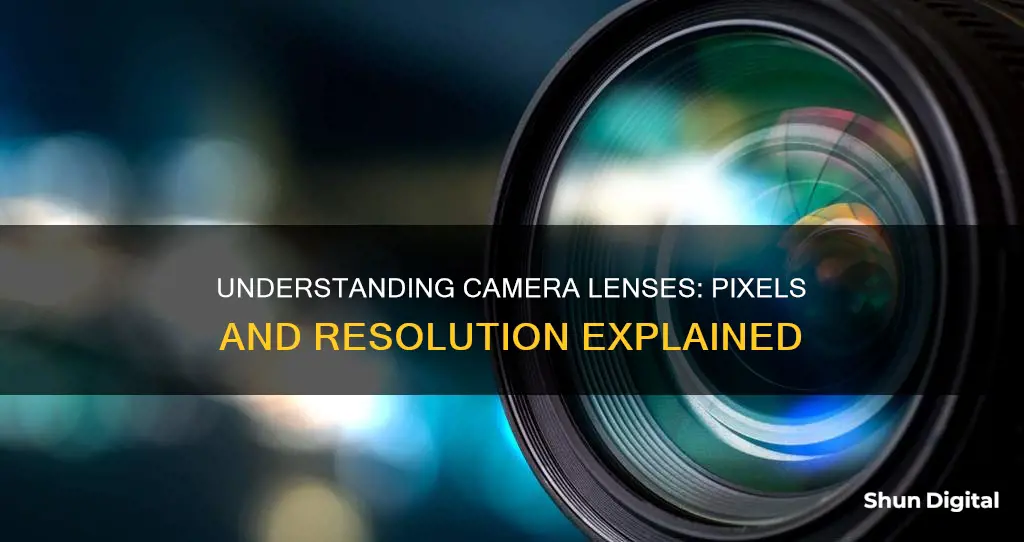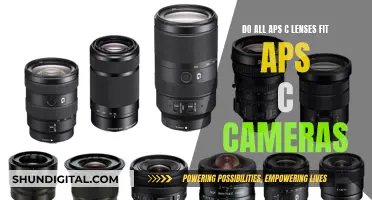
Camera resolution is a complex topic that involves several factors, including the lens, sensor, pixel size, and magnification. In simple terms, resolution refers to the ability of a camera to distinguish between two points on a specimen, with higher resolutions allowing for the capture of finer details. The quality of the lens and sensor play a crucial role in achieving optimal resolution, as does the size of the camera's pixels and the level of magnification used.
While higher resolutions are generally desirable, especially for printing larger images or cropping, it's important to consider the trade-offs involved. For instance, smaller pixels may result in reduced sensitivity, while higher magnifications can decrease the field of view. Additionally, the diffraction limit of light poses challenges for very high resolutions, typically requiring specialist techniques.
Understanding camera resolution is essential for photographers, whether amateur or professional, as it directly impacts the quality and sharpness of their images.
| Characteristics | Values |
|---|---|
| Definition | The shortest distance between two points on a specimen that can be distinguished |
| Factors | Microscope resolution, camera resolution, pixel size, magnification, lens quality, number of megapixels |
| Diffraction Limit of Light | ~200 nm |
| Nyquist Sampling | The sampling rate is doubled, and the max resolution should be twice as high as the smallest object in the sample |
| Line Pairs per Millimeter (lp/mm) | A measure of lens resolution |
| Modulation Transfer Function (MTF) | Quantifies how well a subject's regional brightness variations are preserved when they pass through a camera lens |
What You'll Learn

The role of lens sharpness and resolving power
Lens sharpness plays a significant role in the overall sharpness of an image. It is influenced by various factors, including the quality of the lens, the wavelength of light, the aperture size, and the distance between the lens and the object. A lens with higher resolving power contributes to improved image sharpness by capturing more detailed information from the scene.
The sharpness of a lens is often evaluated using the Modulation Transfer Function (MTF) graph, which illustrates how the lens' sharpness changes from its center to its edge. However, it's important to note that MTF charts may not always provide the full picture, as manufacturers can choose the resolution at which the lens is tested. Therefore, comparing MTF charts between different lenses should be done with caution.
The importance of lens sharpness and resolving power cannot be overstated, especially when paired with a high-resolution sensor. A high-resolution sensor can reveal any shortcomings in the lens' resolving power and highlight slight problems in technique, such as subtle motion blur. This interplay between the lens and the sensor showcases how they are both crucial in achieving the desired image quality.
Additionally, it's worth mentioning that the concept of Nyquist sampling is relevant when discussing lens sharpness and resolving power. Nyquist sampling suggests that there should be at least one camera sensor pixel between two adjacent objects to effectively resolve them as separate entities. This technique enhances the separation of features within a sample and improves the overall resolution.
Tomorrow's Eclipse: Camera Lenses at Risk?
You may want to see also

The impact of sensor size, pixel size and resolution differences
The Impact of Sensor Size, Pixel Size, and Resolution Differences
The resolution of a camera lens is not the only factor that determines the quality of an image. The sensor and pixel size of a camera also play a crucial role in the final output.
Sensor Size
The sensor is the component of a digital camera that is sensitive to light and records an image. Sensors are usually measured in millimetres, with full-frame sensors being the largest commonly available sensors, measuring 35.00 x 24.00mm. Larger sensors have more light-gathering area, which results in better low-light performance and a shallower depth of field. This means that larger sensors can capture more detail and produce sharper images, especially in low-light conditions.
However, larger sensors also require larger lenses, which can be heavier and more expensive. Additionally, the cost of producing digital sensors increases dramatically as their area increases, making larger sensors more expensive.
Pixel Size
The resolution of a camera, or the megapixel count, refers to the number of individual photosites or pixels on a sensor. While a higher megapixel count can result in greater detail, it is not the only factor that determines image quality. The size of each pixel also plays a crucial role.
Larger pixels can capture more light, resulting in better dynamic range and lower image noise. This is because larger pixels have a greater volume and can hold a greater range of photon capacity. As a result, they produce a stronger light signal and a higher signal-to-noise ratio, leading to smoother-looking photos.
However, it is important to note that the amount of background noise also depends on the sensor's manufacturing process and the camera's ability to extract tonal information from each pixel.
Resolution Differences
The resolution of a camera lens and sensor play a crucial role in determining the final image quality. The lens in front of the camera is as important as the sensor in capturing the final image resolution. However, no lens is perfect, and the image sent to the sensor will always have less resolution than the object being captured.
The resolution of a lens is often measured in line pairs per millimeter (lp/mm), which refers to the number of black and white line pairs that can be reproduced within a given unit length. A high-end lens with a higher lp/mm value will result in sharper images compared to a lower-quality lens with a lower lp/mm value.
Additionally, the Modulation Transfer Function (MTF) is a measure of how well a lens preserves contrast and detail as lines become progressively narrower. A perfect lens with an MTF of 1.0 preserves perfect contrast, while values less than 1 result in a loss of contrast.
In conclusion, while a higher resolution is generally desirable, it is important to consider the sensor size, pixel size, and other factors that contribute to the final image quality.
The Art of Rating Camera Lenses: A Comprehensive Guide
You may want to see also

How to calculate the smallest sized feature a given optical system can resolve
Optical resolution is defined as the smallest sized feature that a given optical system can resolve. The resolution of a system is based on the minimum distance at which two points can be distinguished as individuals. This is dependent on the distance between two distinguishable radiating points.
The resolution of a camera lens system is dependent on both the camera and the lens, with the lower of the two typically setting the optical resolution of the system. The optical resolution of a lens is normally specified in line pairs per millimetre and is a function of the optical quality of the lens, including the lens design and the materials used. If a lens is said to be able to resolve 100 lines per millimetre, it means that the lens can resolve up to 100 equally-sized lines that are small enough to fit within a space of 1 mm; for this, each line must be 0.01 mm wide.
The pixel size of the camera will also impact the optical resolution of the system. The limiting pixel size for effectively sampling these lines with camera pixels is 100 μm. If the pixel size is greater than this, the information about the black and white lines will not be sampled properly.
The highest spatial frequency that can be resolved by a sensor, the Nyquist frequency, is effectively two pixels or one line pair. Therefore, the following formula can be used to estimate the camera-pixel-size-limited spatial resolution of a camera:
> Camera pixel size-limited resolution (in lp/mm) = 1000/(2 x pixel size in μm) = 500/(pixel size in μm)
For example, a camera with a pixel size of 3.45 μm has the capability of resolving 500/3.45 = 145 lp/mm.
The effect of diffraction on the optical resolution of a camera and lens system can usually be ignored when the lens iris is set to a low f-number. However, when the iris is set to a high f-number, the system will become diffraction-limited.
The Ultimate Guide to Cleaning Coated Camera Lenses
You may want to see also

The relationship between resolution and contrast
Resolution and contrast are two important factors that determine the quality and sharpness of a digital image. Resolution refers to the ability of a lens to capture details, while contrast refers to the distinction between black and white at a given resolution.
The Modulation Transfer Function (MTF) is a tool used to quantify the relationship between resolution and contrast. It measures how well a lens preserves the regional brightness variations of an image. A perfect MTF score of 1.0 represents the ideal preservation of contrast, while lower scores indicate a loss of contrast. As the MTF score decreases, the distinction between black and white details becomes more challenging, resulting in a lower-contrast image.
The quality of the lens and its ability to resolve details are crucial factors in the relationship between resolution and contrast. Even with advancements in technology, no lens is perfect, and the image it captures will always have slightly less resolution than the object in real life. The limitations of lens quality can be observed through the diffraction limit of light, which poses challenges when trying to capture details at the nanometer scale.
Additionally, the sensor pixel size and total magnification of the imaging system also influence the relationship between resolution and contrast. Smaller camera pixels and higher magnifications lead to improved resolution but come with trade-offs such as reduced sensitivity and field of view.
In summary, while resolution is important, it is the interplay between resolution and contrast that truly determines image quality. The preservation of contrast, as described by the MTF, is essential for maintaining the perceived sharpness and quality of an image. The limitations of lens quality, sensor technology, and magnification settings all contribute to the intricate relationship between resolution and contrast in camera lenses.
Infinity Focus: Are Camera Lenses Capable?
You may want to see also

The importance of camera resolution in digital photography
In digital photography, camera resolution is associated with a number of different factors. The higher the resolution, the larger the potential print size. This is because printing from digital images is accomplished by squeezing a certain number of pixels per inch (PPI). A high-quality print with good details usually involves printing at around 300 PPI, so the size of the potential print is calculated by taking image width and height and dividing them by the PPI number.
The resolution also affects cropping options. The higher the resolution, the more room there is to potentially crop images. Although many photographers avoid heavy cropping, sometimes it is necessary to focus on the desired subject(s). For example, sports and wildlife photographers often resort to cropping, because they might not be able to get closer to the action, but at the same time, do not want their final images to contain unnecessary clutter surrounding the main subject(s).
Resolution also affects down-sampling. The higher the resolution, the better the options for resizing or "down-sampling" images. Modern high-resolution cameras have similar performance as their lower-resolution counterparts, but their main advantages are the ability to down-sample to a lower resolution to decrease the amount of noise and when shooting at low ISOs, the ability to yield larger prints.
Display size is another factor impacted by resolution. During the past 10+ years, there has been a significant increase in display technology. Monitors, TVs, projectors, phones, hand-held and other devices have seen big increases in resolution and the increased space on those devices has led to the need to show higher-resolution images with more detail. 4K TVs and even some 8K TVs are getting more popular and common, which puts more burden on cameras to yield images with enough detail to showcase on such high-resolution devices.
In imaging, the resolution is defined as the shortest distance between two points on a specimen that can still be distinguished. This means that if a camera has a resolution of 1 µm, it can resolve objects in the sample that are more than 1 µm apart. But if objects are closer than 1 µm, the imaging system will be unable to tell them apart, and they will appear as one object. This is why higher resolutions (down to the nanometer scale) are important when working with smaller samples, in order to resolve the fine details.
The camera resolution depends on two main factors: the sensor pixel size and the total magnification. Smaller camera pixels and greater magnifications lead to higher resolutions, but the former comes at the cost of sensitivity (larger pixels are more sensitive) and the latter comes at the cost of the field of view (higher magnifications decrease the imaging area).
The resolution of a lens is usually specified in line pairs per millimeter (lp/mm) and it is a function of the optical quality of the lens, including the lens design and the materials, which contribute to the overall optical resolution of the lens.
The lens in front of your camera is as important to your final image resolution as the sensor, but no lens is perfect. No matter how good your sensor, it doesn’t have a chance at being as good as it can be because the light it receives is already tarnished.
The resolution of a camera lens system is defined as the smallest-sized feature that a given optical system is able to resolve. Resolution is tied to contrast – the ability of the system to discern shades of gray. The optical resolution of a camera and lens system may be said to be camera-limited or lens-limited.
Lens Compatibility: Matching Lenses to Your Camera
You may want to see also







